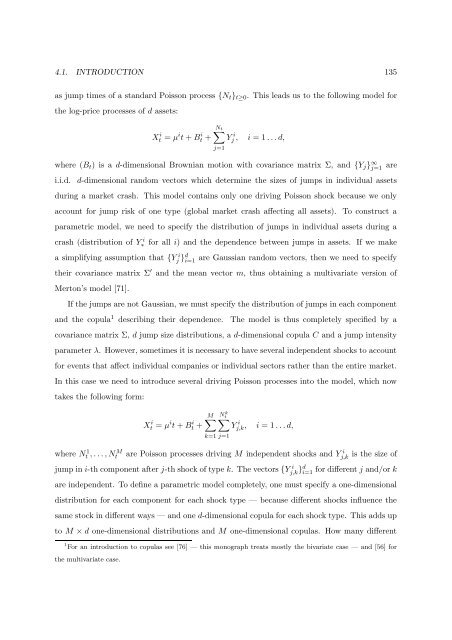Processus de Lévy en Finance - Laboratoire de Probabilités et ...
Processus de Lévy en Finance - Laboratoire de Probabilités et ...
Processus de Lévy en Finance - Laboratoire de Probabilités et ...
You also want an ePaper? Increase the reach of your titles
YUMPU automatically turns print PDFs into web optimized ePapers that Google loves.
4.1. INTRODUCTION 135<br />
as jump times of a standard Poisson process {N t } t≥0 . This leads us to the following mo<strong>de</strong>l for<br />
the log-price processes of d ass<strong>et</strong>s:<br />
∑N t<br />
Xt i = µ i t + Bt i + Yj i , i = 1 . . . d,<br />
j=1<br />
where (B t ) is a d-dim<strong>en</strong>sional Brownian motion with covariance matrix Σ, and {Y j } ∞ j=1 are<br />
i.i.d.<br />
d-dim<strong>en</strong>sional random vectors which <strong>de</strong>termine the sizes of jumps in individual ass<strong>et</strong>s<br />
during a mark<strong>et</strong> crash. This mo<strong>de</strong>l contains only one driving Poisson shock because we only<br />
account for jump risk of one type (global mark<strong>et</strong> crash affecting all ass<strong>et</strong>s). To construct a<br />
param<strong>et</strong>ric mo<strong>de</strong>l, we need to specify the distribution of jumps in individual ass<strong>et</strong>s during a<br />
crash (distribution of Y i<br />
∗<br />
a simplifying assumption that {Y i<br />
j }d i=1<br />
for all i) and the <strong>de</strong>p<strong>en</strong><strong>de</strong>nce b<strong>et</strong>we<strong>en</strong> jumps in ass<strong>et</strong>s. If we make<br />
are Gaussian random vectors, th<strong>en</strong> we need to specify<br />
their covariance matrix Σ ′ and the mean vector m, thus obtaining a multivariate version of<br />
Merton’s mo<strong>de</strong>l [71].<br />
If the jumps are not Gaussian, we must specify the distribution of jumps in each compon<strong>en</strong>t<br />
and the copula 1 <strong>de</strong>scribing their <strong>de</strong>p<strong>en</strong><strong>de</strong>nce.<br />
The mo<strong>de</strong>l is thus compl<strong>et</strong>ely specified by a<br />
covariance matrix Σ, d jump size distributions, a d-dim<strong>en</strong>sional copula C and a jump int<strong>en</strong>sity<br />
param<strong>et</strong>er λ. However, som<strong>et</strong>imes it is necessary to have several in<strong>de</strong>p<strong>en</strong><strong>de</strong>nt shocks to account<br />
for ev<strong>en</strong>ts that affect individual companies or individual sectors rather than the <strong>en</strong>tire mark<strong>et</strong>.<br />
In this case we need to introduce several driving Poisson processes into the mo<strong>de</strong>l, which now<br />
takes the following form:<br />
where N 1 t , . . . , N M t<br />
X i t = µ i t + B i t +<br />
N M∑ ∑t<br />
k Yj,k i , i = 1 . . . d,<br />
k=1 j=1<br />
are Poisson processes driving M in<strong>de</strong>p<strong>en</strong><strong>de</strong>nt shocks and Y i<br />
j,k<br />
is the size of<br />
jump in i-th compon<strong>en</strong>t after j-th shock of type k. The vectors {Yj,k i }d i=1 for differ<strong>en</strong>t j and/or k<br />
are in<strong>de</strong>p<strong>en</strong><strong>de</strong>nt. To <strong>de</strong>fine a param<strong>et</strong>ric mo<strong>de</strong>l compl<strong>et</strong>ely, one must specify a one-dim<strong>en</strong>sional<br />
distribution for each compon<strong>en</strong>t for each shock type — because differ<strong>en</strong>t shocks influ<strong>en</strong>ce the<br />
same stock in differ<strong>en</strong>t ways — and one d-dim<strong>en</strong>sional copula for each shock type. This adds up<br />
to M × d one-dim<strong>en</strong>sional distributions and M one-dim<strong>en</strong>sional copulas. How many differ<strong>en</strong>t<br />
1 For an introduction to copulas see [76] — this monograph treats mostly the bivariate case — and [56] for<br />
the multivariate case.
















